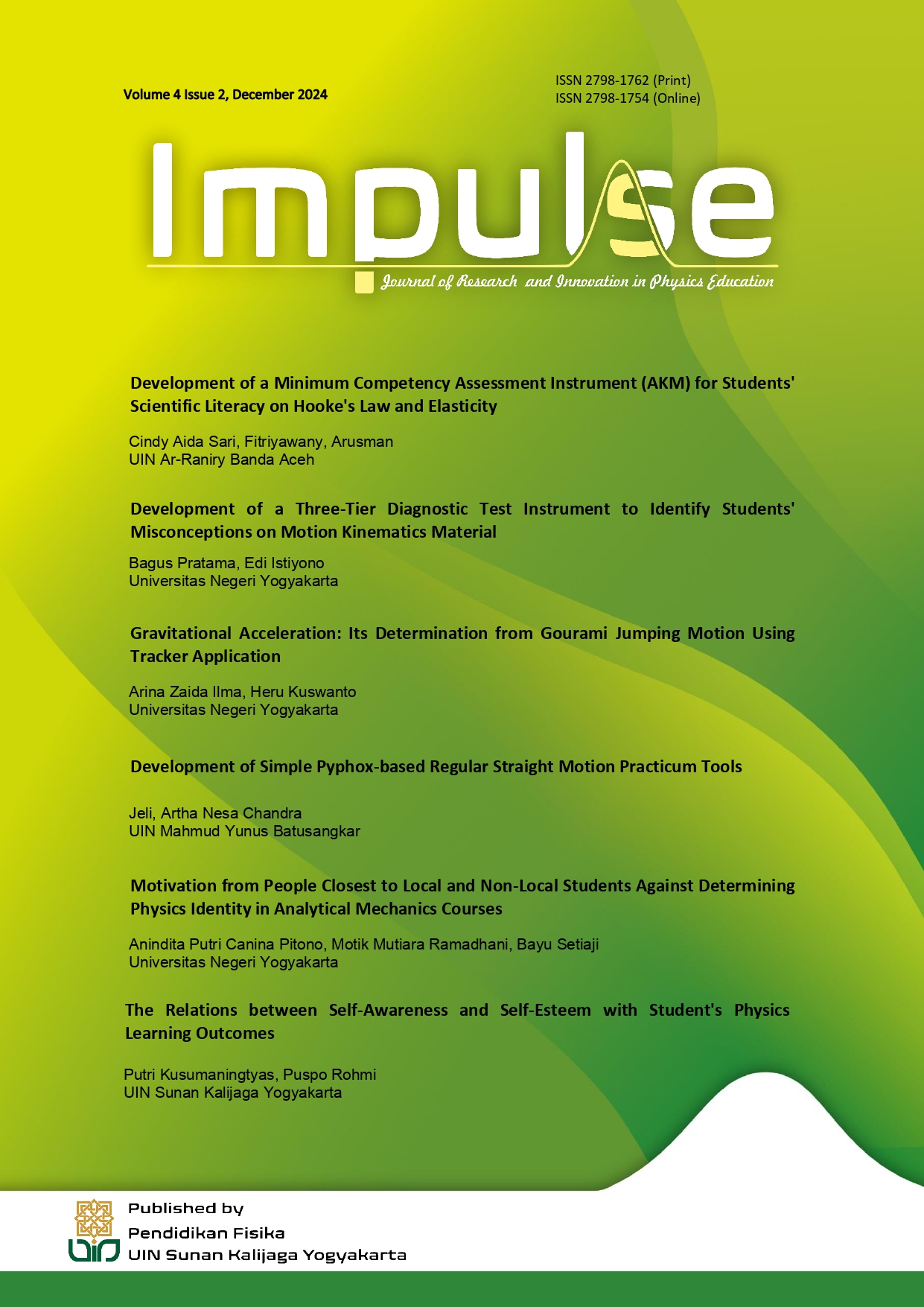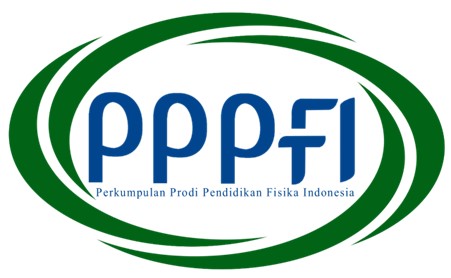Development of a Three-Tier Diagnostic Test Instrument to Identify Students' Misconceptions on Motion Kinematics Material
DOI:
https://doi.org/10.14421/impulse.2023.42-02Keywords:
Assessment instrument, Misconception, Three-tier diagnostic testsAbstract
This research aims to: (1) Know the construction of the three tier diagnostic test instrument to identify misconceptions of high school students (2) Find out the quality of the three tier diagnostic test instrument to identify misconceptions of high school students (3) Know the misconception profile of high school students (4) Find out The level of practicality of the three-tier diagnostic test instrument for identifying misconceptions of high school students.
This type of research is instrument development research using a method adapted from the Oriondo and Antonio model which consists of the test instrument design, test trial and measurement stages. This research was conducted at 4 high schools in Bantul Regency with research subjects of 343 class XI students. Content validity was analyzed using Aiken's V formula. The data analysis technique used is the polytomous item response theory approach according to the Partial Credit Model (PCM). The test characteristics tested include item suitability, reliability, item difficulty level, item characteristic curve, information function and standard error measurement (SEM).
The results of the research show that: (1) The construction of the physics research instrument developed consists of 15 questions including aspects, sub-aspects and indicators that have valid and reliable test items, (2) Based on the criteria for the lowest and highest limit of the mean INFIT MNSQ, namely 0, 77 and 1.30 test items all fit the PCM model. The difficulty level of the test items is in the range between -0.561 to +0.330, which means the test items are in the good category because the value is between -2.0 and +2.0. The total information function of the test is relatively high for abilities between -1.4 to +1.5, (3) The students' misconception profile obtained the highest misconceptions in the rectilinear motion sub-material with the medium category, and (4) The practicality of the three-level diagnostic test instrument based on responses students stated that the instrument developed was included in the practical category.
Downloads
References
S. Grusche, “Phenomenon-based learning and model-based teaching: Do they match?,” in Journal of Physics: Conference Series, 2019, vol. 1287, no. 1. doi: 10.1088/1742-6596/1287/1/012066.
A. Fadllan, W. Y. Prawira, Arsini, and Hartono, “Analysis of students’ misconceptions on mechanics using three-tier diagnostic test and clinical interview,” in Journal of Physics: Conference Series, 2019, vol. 1170, no. 1. doi: 10.1088/1742-6596/1170/1/012027.
N. Mukhlisa, “Miskonsepsi Pada Peserta Didik,” SPEED J. J. Spec. Educ., vol. 4, no. 2, pp. 66–76, 2021, doi: 10.31537/speed.v4i2.403.
R. Annisa, B. Astuti, and B. N. Mindyarto, “Tes Diagnostik Four Tier untuk identifikasi pemahaman dan miskonsepsi siswa pada materi gerak melingkar beraturan,” J. Pendidik. Fis. dan Keilmuan, vol. 5, no. 1, 2019, doi: 10.25273/jpfk.v5i1.3546.
S. Anggrayni and F. U. Ermawati, “The validity of Four-Tier’s misconception diagnostic test for Work and Energy concepts,” in Journal of Physics: Conference Series, 2019, vol. 1171, no. 1. doi: 10.1088/1742-6596/1171/1/012037.
N. J. Fratiwi et al., “Overcoming Senior High School Students’ Misconceptions on Newton’s Laws: A DSLM with Inquiry Learning based Computer Simulations,” in Journal of Physics: Conference Series, 2019, vol. 1204, no. 1. doi: 10.1088/1742-6596/1204/1/012023.
W. Wartono, M. N. Hudha, and J. R. Batlolona, “Guided inquiry and PSR in overcoming students’ misconception on the context of temperature and heat,” in AIP Conference Proceedings, 2018, vol. 2014. doi: 10.1063/1.5054433.
A. Busyairi and M. Zuhdi, “Profil Miskonsepsi Mahasiswa Calon Guru Fisika Ditinjau Dari Berbagai Representasi Pada Materi Gerak Lurus Dan Gerak Parabola,” J. Pendidik. Fis. dan Teknol., vol. 6, no. 1, pp. 90–98, 2020, doi: 10.29303/jpft.v6i1.1683.
A. M. Rampengan, K. G. Kumonong, and A. T. Rondonuwu, “Analisis Kesalahan Konsep Mahasiswa Calon Guru Fisika Pada Materi Kinematika Menggunakan Tes Diagnostik Three Tier,” Charm Sains J. Pendidik. Fis., vol. 2, no. 2, pp. 94–98, 2021, doi: 10.53682/charmsains.v2i2.113.
H. Haerunnisa, P. Prasetyaningsih, and L. T. Biru, “Analisis Miskonsepsi Siswa SMP pada Konsep Getaran dan Gelombang,” PENDIPA J. Sci. Educ., vol. 6, no. 2, 2022, doi: 10.33369/pendipa.6.2.428-433.
N. A. K. Asnawi, Tengku Muhammad Sahudra, Dini Ramadhani, Ary Kiswanto Kenedi, Muhammad Rizki Wardana, Gaya Belajar Siswa Sekolah Dasar dan Tes Diagnostik. Yogyakarta: Penerbit Deepubliser Digital, 2023.
A. S. A. Wahyuni, A. Wartawijaya, and M. Hasyim, “Pelatihan Membuat Instrumen Tes Diagnostik Four Tier Test pada Guru SMAN 11 Makassar,” PENGABDI, vol. 3, no. 2, 2022, doi: 10.26858/pengabdi.v3i2.40870.
E. Istiyono, “Diagnostic Tests as an Important Pillar in Today’s Physics Learning: Four-tier Diagnostic Test a Comprehensive Diagnostic Test Solution,” in Journal of Physics: Conference Series, 2022, vol. 2392, no. 1. doi: 10.1088/1742-6596/2392/1/012001.
M. A. Farrosi, W. Siswaningsih, N. Nahadi, and T. Rahmawati, “Profil Miskonsepsi Siswa SMA pada Materi Kesetimbangan Kimia Menggunakan Tes Diagnostik Pilihan Ganda Tiga Tingkat,” J. Ris. dan Prakt. Pendidik. Kim., vol. 10, no. 2, 2022, doi: 10.17509/jrppk.v10i2.52243.
E. A. Soru, H. F. Rares, and J. Caroles, “Penggunaan Three-Tier Diagnostic Test Untuk Pemetaan Tingkat Penguasaan Elektrokimia Mahasiswa Kimia Semester II,” Oxyg. J. Chem. Educ., vol. 2, no. 1, 2020, doi: 10.37033/ojce.v2i1.132.
R. Rachmawati and A. Kurniawati, “Pengembangan Instrumen Penilaian Tes Berbasis Mobile Online pada Prodi Pendidikan Matematika,” Prima J. Pendidik. Mat., vol. 4, no. 1, 2020, doi: 10.31000/prima.v4i1.1891.
A. Maydiantoro, “Model-Model Penelitian Pengembangan (Research and Development),” J. Metod. Penelit., no. 10, 2019.
Y. Efendi and A. Widodo, “Uji Validitas Dan Reliabilitas Instrumen,” J. Kesehat. Olahraga, vol. 7, no. 2, 2019.
L. Qomariyah, “Analisis Tingkat Kesukaran dan Daya Pembeda Butir Soal TOAFL Universitas Hasyim Asy’ari Tebuireng Jombang,” Lisanan Arab. J. Pendidik. Bhs. Arab, vol. 6, no. 1, 2022, doi: 10.32699/liar.v6i1.2549.
A. Z. Zain, T. R. Ramalis, and M. Muslim, “Karakterisasi Instrumen Tes Keterampilan Bepikir Kreatif Berdasarkan Analisis Partial Credit Model,” J. Ilm. Pendidik. Fis., vol. 6, no. 1, 2022, doi: 10.20527/jipf.v6i1.4806.
R. Entino, E. Hariyono, and N. A. Lestari, “Analisis Miskonsepsi Peserta Didik Sekolah Menengah Atas pada materi Fisika,” PENDIPA J. Sci. Educ., vol. 6, no. 1, 2021, doi: 10.33369/pendipa.6.1.177-182.
V. F. Nufus and N. C. Sakti, “Pengembangan Lembar Kerja Peserta Didik Elektronik Berbasis Flipbook Pada Mata Pelajaran Ekonomi Kelas XI,” J. PTK dan Pendidik., vol. 7, no. 1, 2021, doi: 10.18592/ptk.v7i1.4633.
Downloads
Published
How to Cite
Issue
Section
License
Copyright (c) 2024 Impulse: Journal of Research and Innovation in Physics Education

This work is licensed under a Creative Commons Attribution-NonCommercial 4.0 International License.


























